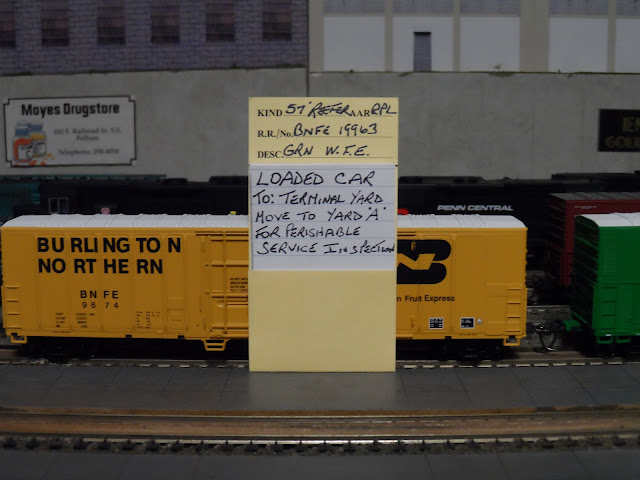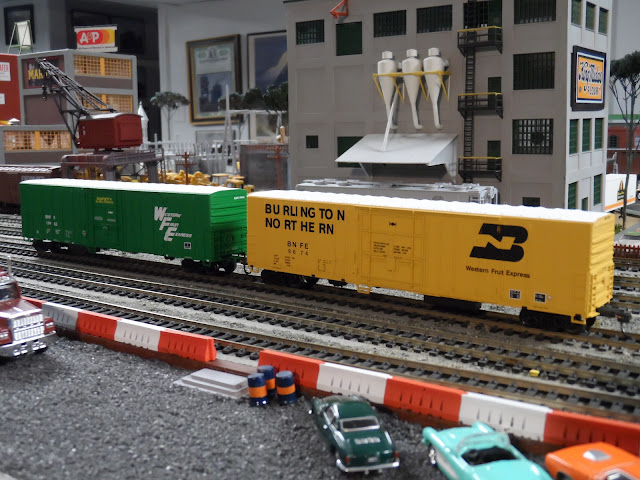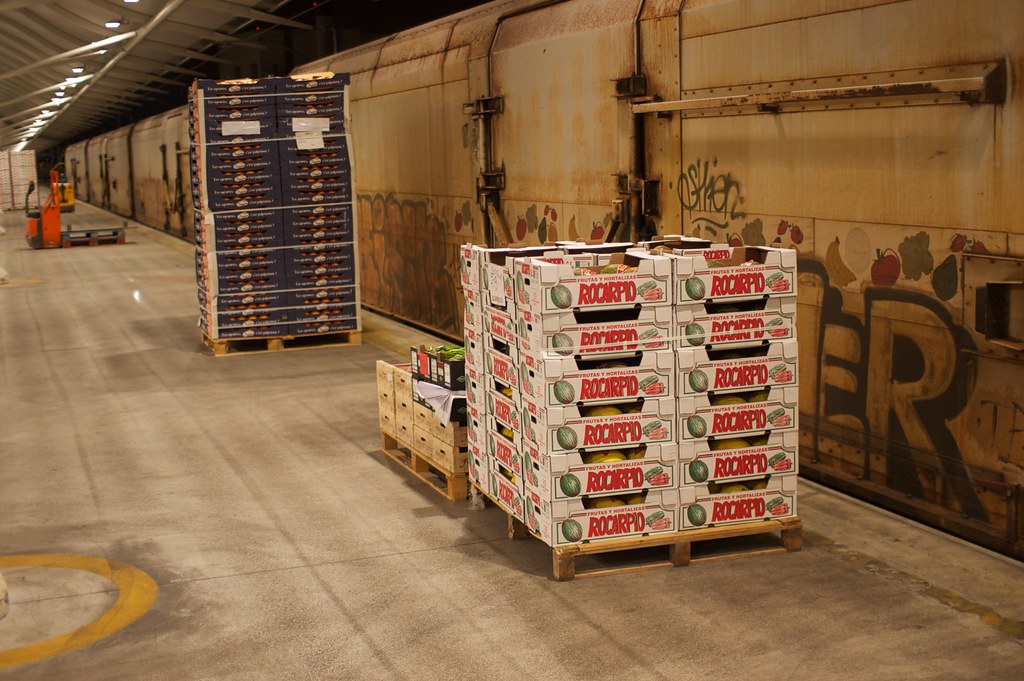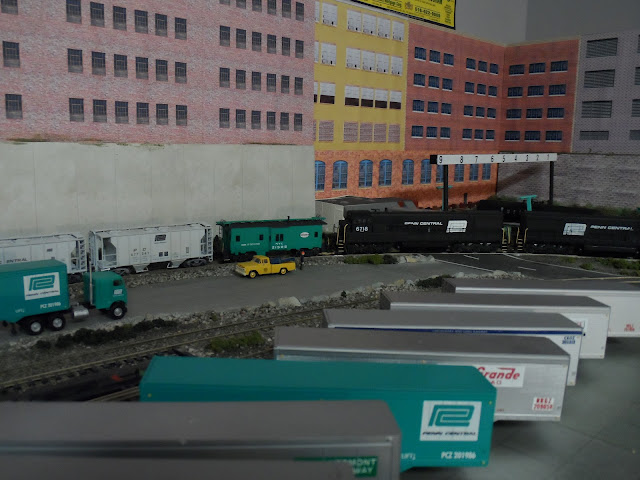Greetings All,
Putting New Rolling Stock into Revenue Service
With new acquisitions of rolling stock from the train store haul comes new work for getting these new freight cars into "revenue service". Making sure the rolling stock meets layout standards is only the first step now that car card and waybill operations have been instituted and I seek more prototypical operation from my models.
NMRA and Layout Standards
The National Model Railroad Association (NMRA) set forth a list of recommendations and standards for modelers to follow to maximize the reliable running for their locomotives and rolling stock. These include but are not limited to track curvature, rolling stock weight, switch points, wheel spacing, coupler height, etcetera. See the below NMRA link for more.
I started putting some of these standards into place over twenty five years ago for my own locomotives and rolling stock and most recently took to adding additional weight to the rolling stock where warranted. I continue to keep the fleet up to what I call my own layout standards.
Minimum Layout Standards for Rolling Stock
Free rolling metal wheels, wheel faces painted with black or burnt umber, knuckle couplers with metal springs preferably Kadees, a spray of Testor's Dullcote to the shell at minimum, trucks and underframe painted with flat black or brown depending on car color, and additional weight.
For today we'll focus on the Athearn Ready to Roll BNFE Western Fruit Express 57' Reefers that I purchased as part of the great train store haul documented in the prior blog entry.
It rolls freely now!
Now that two out of the three 57' reefers are up to layout standards its time to put them into revenue service. The third reefer did not meet layout standards and required additional work. More on this car at the end of this post.
A Burlington Northern Western Fruit Express Story
In the Classic Trains Spring 2021 magazine article titled "The Cherry Letter" author Robert J. Kale tells of his experiences working in the Security & Freight Claim Prevention Department for the BN at Northtown Terminal in the Twin Cities in 1974.
"BNFE" by ATSF104 is licensed under CC BY-ND 2.0. To view a copy of this license, visit https://creativecommons.org/licenses/by-nd/2.0/?ref=openverse.
"Around mid June Washington state cherries began to move to Chicago by rail thru Minneapolis and continued into August. These were considered high value loads and the "Cherry Letter" issued to each patrolman made it abundantly clear that cherry car shipments arriving at or located in Northtown terminal must be inspected and patrolman were expected to drop everything to find and inspect and cherry shipments passing thru the yard. Failure to do so would result in a strong personal reprimand or even dismissal".
"BNFE" by ATSF104 is licensed under CC BY-ND 2.0. To view a copy of this license, visit https://creativecommons.org/licenses/by-nd/2.0/?ref=openverse."The group that maintained and serviced the refrigerator cars for BN was known as Western Fruit Express. WFE had an office at Northtown and a small work force. The S&FCP and WFE personnel performed the same cherry car inspections but only the WFE had the ability to fuel and adjust or repair refrigerator car equipment. Apparently the S&FCP were conducting cherry car inspections to ensure the WFE did its job". Author Kale goes on to tell an interesting story about one night dealing with the cherry cars.
Into the Rabbit Hole of Model Railroad Operations
with Car Cards and Waybills
After beginning to use the car card and waybill model railroad operating system for my railroad I joined the Operations Special Interest Group to further my knowledge for prototypical operation of my freight car fleet.
Moving the BNFE Reefer cars from an off layout shipper to an on layout consignee offers some interesting prototypical operations following some of the AAR car service rules of the late 1960s and special requirements for refrigerator cars.
Western Pacific Fruit Express Reefers Car Movements
After the BNFE Western Pacific Fruit Express 57' reefers have arrived in Terminal Yard their first move is to Yard 'A' for Perishable Protection Service Protection inspection.
The Yard 'A' switcher picks up the reefers from Terminal Yard. Remember special cars require special treatment.
Once the inspection is completed, either in this op session or sometime in the future, the waybill is placed on top of the movement slip indicating the car is ready for delivery to its consignee, in this case Empire Produce in Empire City, NY.
Once in Terminal Yard they will be put into an outbound freight train for movement off layout.
"BNFE" by ATSF104 is licensed under CC BY-ND 2.0. To view a copy of this license, visit https://creativecommons.org/licenses/by-nd/2.0/?ref=openverse.After they are returned to the BN they will get loaded off layout for other on layout and one off layout consignees.
"Refrigerator car 2" by kev_walsh is licensed under CC BY-NC-SA 2.0. To view a copy of this license, visit https://creativecommons.org/licenses/by-nc-sa/2.0/?ref=openverse.When the BNFE Reefers Return
In all instances as the loaded reefers arrive back on layout in Terminal Yard the movement slip (a cut down index card) will have the cars move to Yard 'A" for perishable protection service inspection.
"Broken Furnace, color wash" by jronaldlee is licensed under CC BY 2.0. To view a copy of this license, visit https://creativecommons.org/licenses/by/2.0/?ref=openverse.
Repairs if needed will be undertaken in Yard 'A' if possible to minimize delays in delivery.
"Freight Car Repair 1" by Jack Snell - Thanks for over 26 Million Views is licensed under CC BY-NC-SA 2.0. To view a copy of this license, visit https://creativecommons.org/licenses/by-nc-sa/2.0/?ref=openverse.
When the inspection is completed the reefers get moved according to their waybills. Using waybill cycle #2 our WFE reefers have come from Pacific Fruit in Bellingham, Washington loaded with produce for consignee Birdseye at the Terminal Warehouse and Cold Storage complex in East Bedford NY.
Reefers, Reverse Routes, Record Rights
Railroad refrigerator cars, also known as reefer cars, are subject to special handling under car service rules whether owned by a railroad or private shipper. One of these rules is Car Service Directive 145-U.
"ARMN 766205" by contemplative imaging is licensed under CC BY-NC-SA 2.0. To view a copy of this license, visit https://creativecommons.org/licenses/by-nc-sa/2.0/?ref=openverse.
Using Car Service Directive 145-U
CSD-145U suspends Car Service Rules 1 and 2 for the classes of cars covered. Empty cars moving home are accompanied by a revenue waybill without charges showing full routing and all junction points.
Assigned car CSD-145U In effect in the late 1960s refers to certain classes of empty cars including RBL and RPL reefers that were to be returned to the agent at the origin of the last load in reverse of the loaded movement.
Unassigned car CSD-145U: In effect in the late 1960s. In this case when empty the car is handled "per owner's or lessee's instructions or returned empty or loaded to owner or lessee". Basically the owner or lessee can direct where the car goes when made empty. If the owner or lessee exercised rights to control the disposition of the cars under CSD-145 then they would incur charges under car service rule 5 to the cooperating RRs.
The simple "car movement slip" that returns the car to the BN at Cicero, Illinois is enough to send the car on it's way home as an assigned CSD-145U car.
"reefer madness" by contemplative imaging is licensed under CC BY-NC-SA 2.0. To view a copy of this license, visit https://creativecommons.org/licenses/by-nc-sa/2.0/?ref=openverse.
Movement Slips and Waybills
While the waybill directs the car towards its intended consignee the movement slip offers additional operations for yard crews. The loaded reefer car handling requirements of protective perishable inspection adds a prototypical car movement or two after the car arrives in the yard but before it departs for its consignee.
At Terminal Yard this is accomplished in two car movements after the car arrives in a train which has been inspected by the carmen. Move one is to Yard A for the inspection. Move two is either back to Terminal Yard for movement to its consignee or directly to consignees located in the Terminal Warehouse and Cold Storage complex as noted in waybill cycle 2.
To Add the Moves or Not Add The Moves?
In model railroad operations the inspection of arriving trains by the car knockers is basically a non event in some cases. Off camera the train comes in and gets broken down without the delays of car inspection.
Simulating perishable protection servicing and inspection may be performed on a track in the receiving yard without the need to move the car to a separate track or yard if you have an available track that has clearance for an inspection truck or access to a road.
My Terminal Yard track spacing only allows for this on running tracks 8 and 9 as seen above which will clog the yard so that is the main reason to move the cars to Yard 'A'.
Further into the Rabbit Hole We Go
More Car Movements
A movement slip for moving the empty car off layout offers the yard crew a way to block and classify their outbound trains to the various interchanges with other railroads and adds some more prototypical practices and interest.
Empties to Cicero, Illinois
The movement slip for returning the BNFE reefer cars to the BN via the reverse route from the imagined Empire City area of New York looks to be to the BN Cicero Yard in Cicero, Illinois just outside of Chicago where the Penn Central interchanged westbound freight cars with the BN.
Sample Car Routing
Westbound freight cars traveling to Chicago from the New York City area or in our case Empire City would be placed into NYC / PC Train SLX-1 that would leave 72nd Street Yard in Manhattan or in our case Terminal Yard for Perlman Yard in Selkirk, NY.
After being humped and classified at Selkirk the Chicago bound freight cars would be placed in Train BC-1 for movement to the electronic hump yard at Elkhart, Indiana. At Elkhart all westbound trains were reclassified for direct delivery to western connections.
After classification at Elkhart the BNFE cars would be placed in PC Train BN-1 for delivery to the BN at Cicero, Illinois.
Loading Points
When researching for railroads and loading points that make some sense to me for the car(s) in question I use the Opsig Industry Database available online (see link below). All of the shippers for the BNFE cars are served by the BN. This gives the car(s) some imagined movement when off layout.
The Case of the Missing Reefer
What about that third WFE reefer? Only two of the three BNFE reefers were put into service for this post. The third 57' reefer did not meet layout standards and was pulled from service as it leaned very noticeably to one side in photos and videos.
Final Thoughts and Comments
In the span of thirty years I've gone from a loop of track and a few trains to a sizeable fleet of locomotives and rolling stock that in each passing decade in the hobby have benefitted from the adopted "layout standards".
With reliable track and equipment I'm able to focus more attention to the prototypical aspects of freight car transportation and forwarding which is now a hobby within the hobby for me. A rabbit hole for sure but it opens up new ideas for running the model railroad which in turn adds to the fun.
Additional Reading and Links
Dispatcher's Office Magazine, The Official Publication of the Operations Special Interest Group Transportation Series by Eric Hiser.
BNFE 8853 at Elmira, NY.
BNFE 9303 at Sommerville, Mass.
BNFE 9490 at Burlington Washington.
Car Service Directives google search.
Thanks for reading!!!
See you soon!!!





























Hats off to John and the crew on the N.Y.C.T.L. 👍 You have taken the hobby to another fine level with your attention to prototype and operations. I throughly enjoyed the information about the WFE and their operations. I had no idea that cherries were such a hot commodity. I’ve been in the Bitteroots around Polson. It’s a beautiful part of Montana. I learned a lot about the special handling of perishable commodities from your research and some great information on fine tuning rolling stock for optimal operation. A very enjoyable post 👍🚂
ReplyDeleteThank you very much ATJOE!!! I thought of you and your video using the truck tuner when I was drilling out the trucks to get that reefer car to roll better. The temperature sensitive and short life span loads like cherries and fresh cut flowers demanded special and speedy handling by the RRs which in most cases they met. Not all, but most...
DeleteWell done article about the reefers and of course, your diligent work on making sure that your rolling stock conforms to not only the NMRA standards, but the standards of the NYCTL! Reefers are one of the freight cars that must be in perfect working order so perishables arrive to the consignee fresh or frozen, depending on what is being shipped. I do know that the BN was a large user of these freight cars as were other railroads in the Northeast, like the EL!
ReplyDeleteGreat job Sir John!
Thank you very much 1:1 Sir Neal!! Glad you enjoyed the article and as a model railroad operator who runs many a reefer car you know that operating perishable traffic on a layout needs to be done right.
DeleteA nicely done thorough exploration of car movements using the latest finely tuned rolling stock acquisitions as examples! I always admire your efforts to ensure your freight car roster runs as well as possible. Following the movements of the BNFE reefer was enjoyable with the well imagined routing and extra moves related to car servicing. I'd like to know ore about the cherry shipments going though Minneapolis and Northtown Yard which is only a few miles from my home! Hopefully the frozen fish lads were never misplaced by the Penn Central! This is a great post that I think could make a interesting article!
ReplyDeleteThank you for the compliments Ralph!!! Glad you enjoyed the post and thank you for the vote of confidence about submitting it as a magazine article.
DeleteRide in luxury with top-rated black car service nyc, perfect for airport transfers, business meetings, and special events. Enjoy sleek vehicles, professional chauffeurs, and punctual service throughout New York City. Whether for work or leisure, experience comfort, privacy, and style with NYC’s premier black car transportation.
ReplyDeletetruck repair Abbotsford
ReplyDeletetruck repair Coquitlam